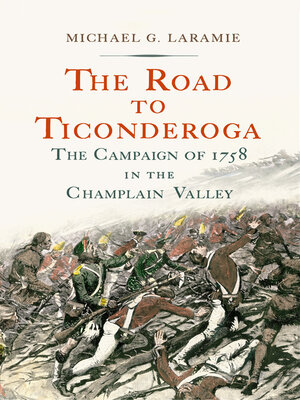
Sign up to save your library
With an OverDrive account, you can save your favorite libraries for at-a-glance information about availability. Find out more about OverDrive accounts.
Find this title in Libby, the library reading app by OverDrive.



Search for a digital library with this title
Title found at these libraries:
| Library Name | Distance |
|---|---|
| Loading... |
The British campaign to capture Fort Carillon on the Ticonderoga Peninsula in 1758 resulted in the largest battle of the French and Indian War. Crafted by Prime Minister William Pitt, the scope and scale of the British effort was staggering, calling for their northern colonies to raise 20,000 men to rendezvous with the British Regulars at Albany. The directive would test the patience, resources, and will of the colonial governments as well as that of the newly appointed the British commander-in-chief, General James Abercrombie. For the defenders of New France matters were dire. Reports were arriving that Abercrombie's numbers were over twice the entire fighting strength of Canada. For the French field commander, the Marquis de Montcalm, there were few options. The Marquis had long opposed defending frontier forts, calling for abandoning these posts at the first sign of threat in order to conserve the colony's resources. The French Governor disagreed and dispatched Montcalm and his white-coated French regulars with orders to defend Fort Carillon. With his army the only thing that stood between the British and the interior of Canada, there appeared to be a single path before the Marquis. Whether the Governor liked it or not, a rearguard action followed by a retreat down Lake Champlain was the only answer that would leave the army of Canada in position to fight again. Yet, within the span of a few days Montcalm would set these views aside, and suddenly risk both his army and the fate of Canada on a single risky battle.
Based on journals, letters, and accounts of the participants on both sides, The Road to Ticonderoga: The Campaign of 1758 in the Champlain Valley by Michael G. Laramie recounts this unexpected tale of victory and defeat on the North American frontier. Here we learn how the unexpected death of a dynamic leader, George Howe, elder brother of Richard and William, nearly crushed "the soul of General Abercrombie's army," leading to misinterpreted orders and hesitation on the part of the British. At the same time, the French commander perilously underestimated the ability of his own forces while overestimating his enemy's before his fateful and unexpected decision to make his stand at Ticonderoga. With lessons and repercussions for future warfare in North America, The Road to Ticonderoga shows how a series of small mistakes can cascade into a catastrophe under weak leadership—or be exploited by a strong one.
Based on journals, letters, and accounts of the participants on both sides, The Road to Ticonderoga: The Campaign of 1758 in the Champlain Valley by Michael G. Laramie recounts this unexpected tale of victory and defeat on the North American frontier. Here we learn how the unexpected death of a dynamic leader, George Howe, elder brother of Richard and William, nearly crushed "the soul of General Abercrombie's army," leading to misinterpreted orders and hesitation on the part of the British. At the same time, the French commander perilously underestimated the ability of his own forces while overestimating his enemy's before his fateful and unexpected decision to make his stand at Ticonderoga. With lessons and repercussions for future warfare in North America, The Road to Ticonderoga shows how a series of small mistakes can cascade into a catastrophe under weak leadership—or be exploited by a strong one.







